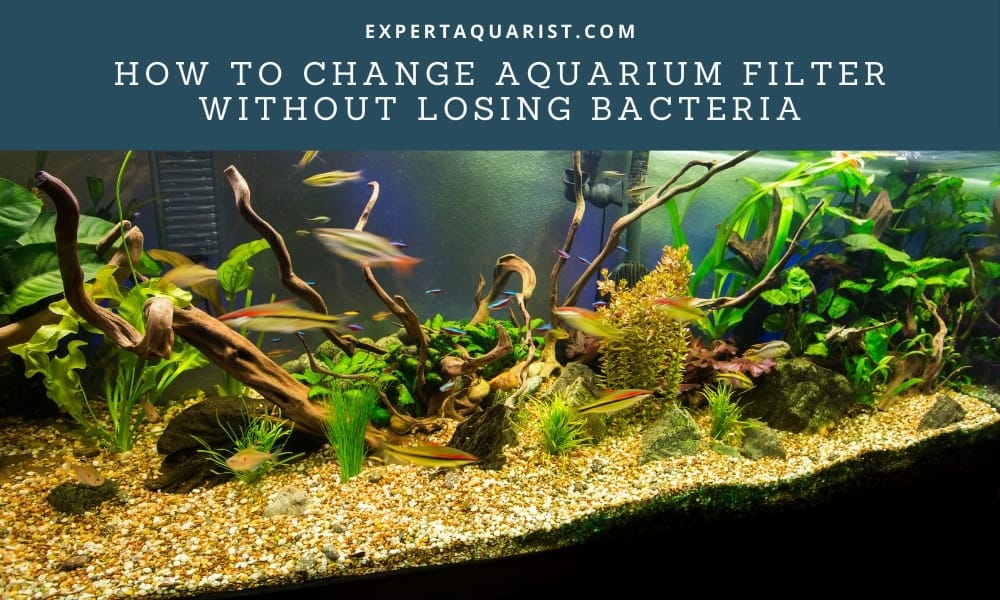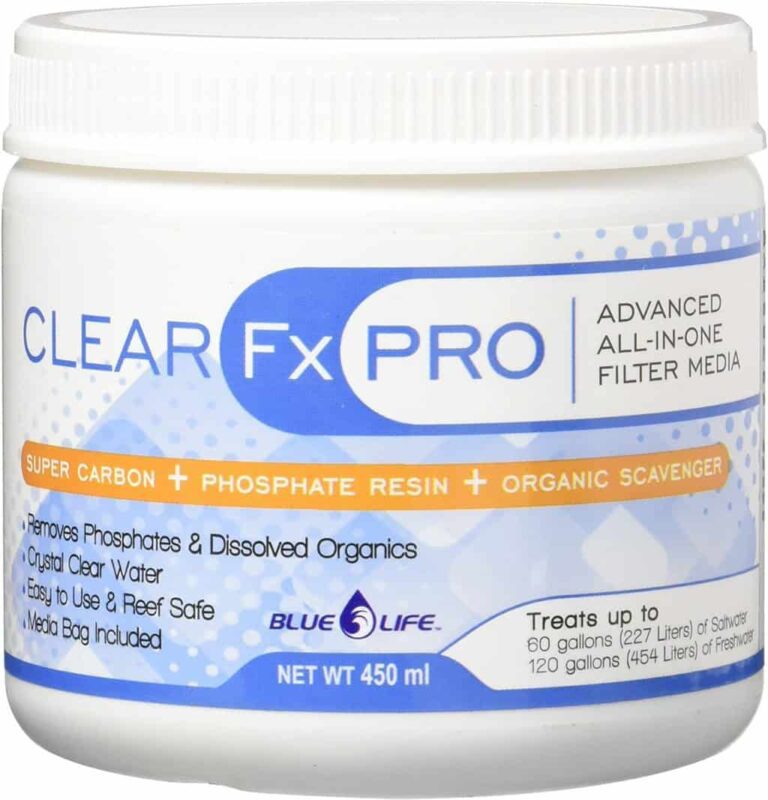Any expert aquarist should already know what an asset bacteria is to an aquarium. This is why they let them thrive inside the filter, but eventually, you’ll need to change it, making you lose a lot of the bacteria colony.
But that’s not written in stone. If you plan ahead and make a steady transition into a new filter, you can keep the majority of your bacteria.
There are 3 ways you can efficiently change the filter without losing beneficial bacteria- You can reuse the media from the previous filter or keep both filters together until the older one breaks down; alternatively, let the bacteria colonize the new filter.
I’m confident that I have your attention. So if you want to know about how to change aquarium filter without losing bacteria in a detailed manner, then all you have to do is- scroll!
3 Easy Ways To Change Aquarium Filter Without Losing Bacteria
Changing an aquarium filter isn’t a big deal; you just need to put in a lot of attention than other daily things you do. Because, if you don’t do this part with full dedication, you’ll be losing a lot of healthy bacteria.
The most important thing you have to remember is – never change all your filter or filter media at once. Because if you change it at the same time, you’re causing a biological imbalance.
As a sudden change like that will leave you with a lack of sufficient bacteria, your aquarium will be a mess. This is because there are not enough bacteria to break down the uneaten fish food and organic wastes.
So, you need to ride this transition period at a steady pace.

Okay, now that we have that out of the way, let’s have a look at how to change aquarium filters:
Keep old and new filter together
I’ll start off with the easiest one first. Here, you have to leave the old filter with the new one for a month at least. Afterward, you can take the old filter out.
We do this so that the new filter has enough time to stand on its own and keep the aquarium’s balance.
I’ll request you to keep a close eye on the flow rate, too high a flow rate is detrimental for your young fish, because they have to constantly swim against the strong current and they can’t keep up with it and are in a lot of stress.
You can use filter pads to keep the flow rates slow. A benefit of doing that is slow rates are excellent at maintaining carbon dioxide levels inside the aquarium. So, if you have plants, then they’ll greatly benefit from that.
You could also let the old filter be where it is until it’s broken down completely; there will be no harm to your aquarium if you do that.
And you also lose the minimum amount of bacteria this way.
Reuse previous filter’s media
If you don’t wish to keep the old filter inside, fear not; there’s another way too. Here, you just have to act smartly. So what’s the plan? You remove the filter but take out its media and use it on the new one.
This way, you won’t have to fear losing your bacteria. And since you shouldn’t change all your filters simultaneously, the bacteria have a chance to settle at the new filter.
After a month or so, you could change the cartridge if you wish to because by then, the bacteria will be comfortable in the new filter. This way, there are no drastic changes. You could also keep the old media if you want.
There are a few possible problems with this approach.
Firstly, the new filter has to be identical to the old one in terms of shape and size; otherwise, the media won’t be able to fit.
Secondly, you’ll have to be content with the same filter; getting a larger size or one from another brand might not be possible.
So please keep that in mind if you wish to choose this solution.
Colonizing the bacteria onto the new filter
You need to take this approach if the media doesn’t fit the new filter and you don’t want two filters running at the same time.
When you take out the old filter, remove its cartridge and put it inside the aquarium after you’ve installed the new filter. Remember to check if it’s in good condition or not.
In a month, the bacteria should be able to colonize the new filter. And you should take out the old media at that time.
So these were the three easy but effective ways to change aquarium filters without losing any bacteria. You have nothing to worry about if you’ve followed them appropriately.
How changing filters can make you lose bacteria
Bacteria settle inside an aquarium by attaching themselves to solid spaces. Like the walls, structures, rocks, etc. But they settle in most concentration in a filter media because that’s the most suitable place for them to propagate.
So, when you change the filter, you’re taking that big chunk of bacteria out as well. And that leaves your aquarium with loads of waste to deal with.
Although bacteria also live in the substrate, the amount isn’t nearly enough to get your aquarium to a safe living condition.
Ultimately, your aquarium ends up with a deficit of bacteria.
Why bacteria is essential in an aquarium
While many people believe all bacteria to be bad news, that is not 100% true. We need beneficial bacteria in our aquarium; they break down debris and waste for and keep the aquarium water fresh and clean.
Most importantly, they conduct the nitrogen cycle. I’ll explain what it is in case you’re unaware of the concept –
Especially in a new aquarium, ammonia spikes are a common sight because the bacteria haven’t established themselves yet. The ammonia are broken down into nitrite first then into nitrate, which is less dangerous. This whole event is called the nitrogen cycle.
This is why you need to have beneficial bacteria and let them settle before you add any fish.
If these bacteria are so important right off the bat, I hope you can assume how valuable they are throughout the ordeal. There are no alternatives for them.
How do I get good bacteria in my fish tank?
We’ve already discussed how important beneficial bacteria are for a fish tank. Having more of these little friends isn’t a bad idea by any means. To increase the number of beneficial bacteria in your tank, you need to:
- Increase oxygen levels in your aquarium
- Keep water temperature around 85 degrees Fahrenheit
- Have scheduled lighting so they can grow faster in the dark
- Let the filter run during the nitrogen cycle
- Add more filter media
- Don’t put “too many” fish in the tank
These are a few ways you can increase the number of good bacteria in your tank. All of these are good ideas, but the most effective one is to add filter media – gravel works the best.
However, do keep in mind that the number of bacteria is directly related to the amount of ammonia production. So, try to keep things in moderate quantity to maintain equilibrium.
How often should aquarium filters be changed?
Well it depends on the type of filtration and the product. There are three types of filtration media – mechanical, biological and chemical. Mechanical filtration media, like sponge, gets clogged easily and looses temper with time. You can replace it by checking the condition. Biological filtration media lasts a long long time and usually don’t need to be changed. Chemical media, like charcoal or activated carbon needs to be replaced every few months.
Can filters kill fish?
Technically, yes. If the water current is too strong for the fish then it wouldn’t be able to rest, causing it to get exhausted. And eventually, it’ll get weak or sick. These later could get sucked into filters.
Healthy and strong fish have no risk from filters. This is why I urged you to keep an eye on the flow rates.
Aquarium filter misconceptions
Due to a lack of research and trial, there have been many myths surrounding aquarium filters and bacteria. While most of them are harmless and just slow down your effectiveness, some of them could end up hurting your aquarium.
The biggest misconception of them all is that- “beneficial bacteria only live inside the filters”. This leads to two short-sighted assumptions:
Misconception 1: Any bacteria outside the filters is bad
A healthy aquarium with a working filter will have beneficial bacteria roaming all over the tank. It is true the majority of the bacteria does grow on filters but that doesn’t mean the rest of them are expendable.
An owner who believes such a myth is prone to clearing these out and that puts their aquarium into chaos.
Misconception 2: Switching the filter could end up hurting the aquarium
This makes people hesitant to change their filters. But if one delays the inevitable, they’ll see stagnation in their aquarium. Switching the filters is entirely safe as long as one does it properly and without haste.
And the methods I shared with you are good enough; there is no need to worry.
So, as you can see both are untrue. There are many more myths like that, so please do your research and think before you come to a conclusion.
Let the bacteria thrive!
Beneficial bacteria are an important asset that’ll drive your aquarium towards prosperity. Yes, changing the filters blindly would indeed cause you to lose most of them.
Now that you know how to change aquarium filter without losing bacteria, I’m sure you’ll be able to shrewdly work your way around that limitation and come out without losing too much.
The three methods I mentioned are proven and will help you a lot. You can expect good things, all the best!






